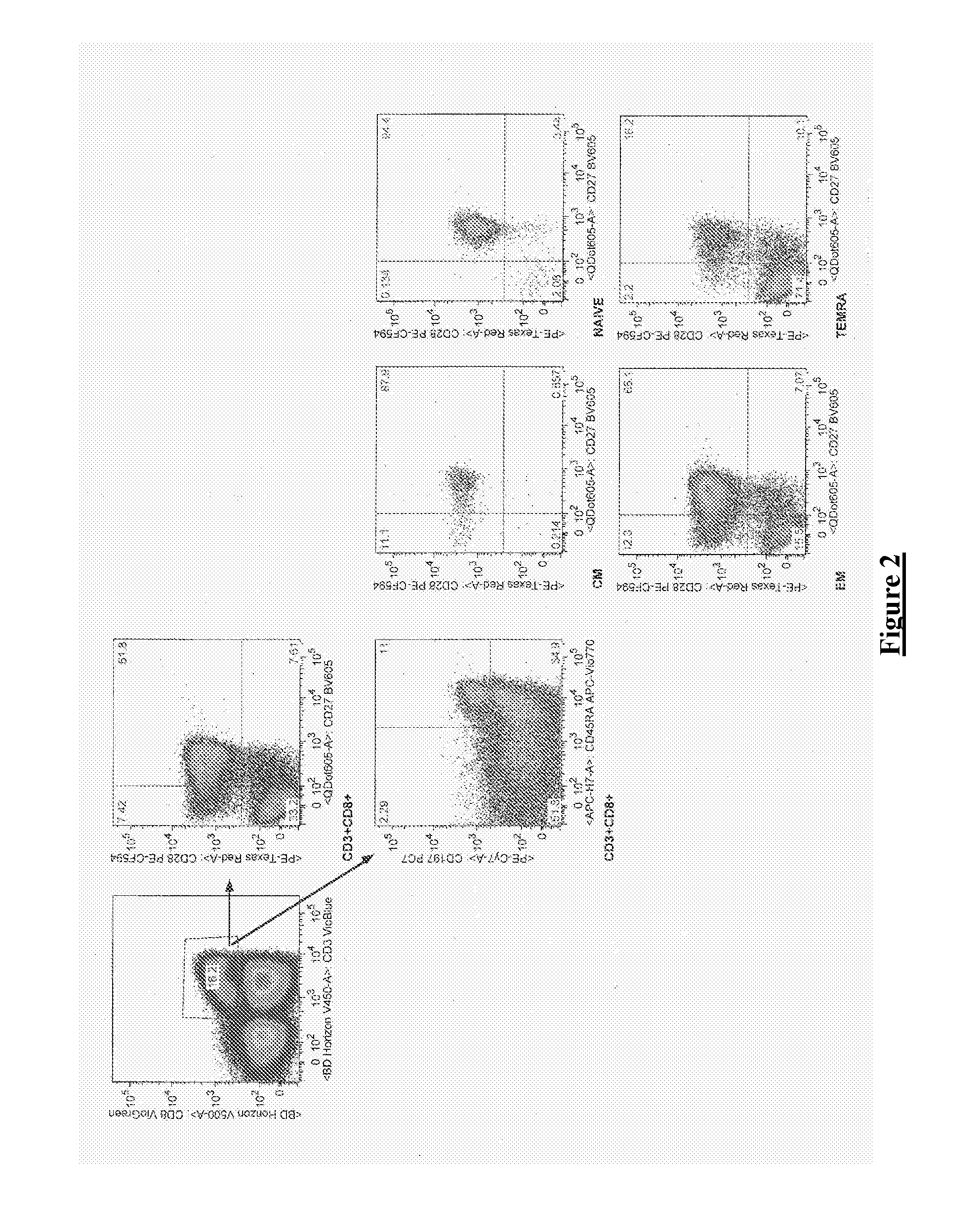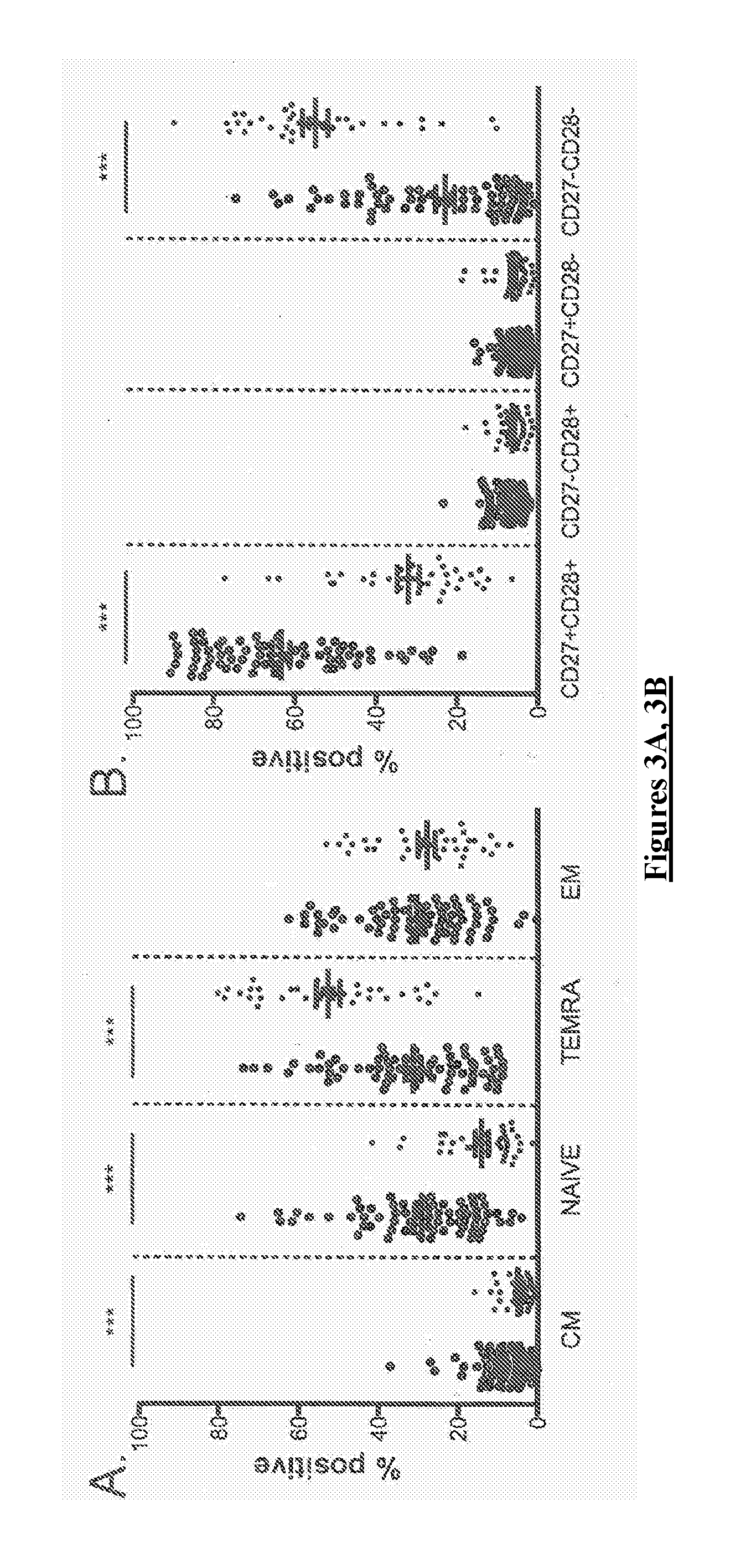Markers for long-term kidney graft dysfunction
a long-term kidney graft and marker technology, applied in the direction of antibodies, instruments, antibody medical ingredients, etc., can solve the problem of deficiency in the differentiation of effector cd8 t cells in patients with higher risk of long-term kidney graft dysfunction, and achieve stable graft function and improve the identification of such at-risk patients
- Summary
- Abstract
- Description
- Claims
- Application Information
AI Technical Summary
Benefits of technology
Problems solved by technology
Method used
Image
Examples
example 1
Reduction in TCR Vβ Repertoire Diversity is Associated with an Increase of Highly Differentiated TEMRA (CD45RA−CD197−CD27−CD28−) CD8 Effector T Cells
[0204]Among the 131 patients with a stable graft function under standard biotherapy immunosuppression at the time of inclusion (median time post-transplantation 7.78 years—range 5.01-21.66), 45 exhibited a restricted TCR Vβ repertoire at inclusion in the study (median time post-transplantation 6.55 years—range 5.11-19.58) and 86 did not (median time post-transplantation 8.10 years—range 5.01-21.66) (see FIG. 1). The stratification of restricted vs. diverse TCR Vβ repertoire was based on the results obtained using a previously published unsupervised statistical method (i-e a method aim to identify subgroup of patients based on expression of markers without prior knowledge of the existence of different groups of patients) (positive value of the first Principal Component Analysis Covariate 1; PCA1). By measuring a broad array of phenotypic...
example 2
CD8 T Cells in Patients with Restricted TCR Vβ Repertoire Demonstrated a High Expression of Cytotoxic Molecules (Granzyme B and Perforin) Compared with Patients with a Polyclonal TCR Vβ Repertoire
[0213]Late differentiated phenotype is associated with a high cytotoxic capacity, characterized notably by the expression of cytotoxic molecules such as granzyme B and perforin (see Appay et al. Memory CD8+ T cells vary in differentiation phenotype in different persistent virus infections. Nat. Med. 2002; 8(4):379-385; Hamann et al. Phenotypic and functional separation of memory and effector human CD8+ T cells. J. Exp. Med. 1997; 186(9):1407-1418).
[0214]Results
[0215]On average, 64% of CD8 T cells in patients with polyclonal TCR Vβ repertoire express none of the cytolytic molecules whereas the frequency of GZM-B−PERF− was only of 39% in patients with a restricted TCR Vβ repertoire (p=1.67×10−7; FIG. 4). A significant increase of CD8 T cells expressing either GZM-B only (28.04±3.05; p=0.007) ...
example 3
CD8 T Cells in Patients with Restricted TCR Vβ Repertoire Expressed Higher Levels of T-bet Than Patients with Diverse TCR Vβ Repertoire
[0221]Expression of the T-box transcription factor T-bet has been associated with effector phenotype and cytotoxic potential in resting CD8 T cells. As previously reported, three populations can be defined based on the expression of T-bet: T-betneg, T-betdull and T-bethigh (see Hersperger et al., Increased HIV-specific CD8+ T-cell cytotoxic potential in HIV elite controllers is associated with T-bet expression. Blood. 2011; 117(14):3799-3808).
[0222]Whereas the frequency of T-betdull CD8 T cells was similar between patients with diverse or restricted TCR Vβ repertoire, patients with a restricted TCR Vβ repertoire exhibit a marked increase in T-bethigh CD8 T cells (44.05±4.05 vs. 25.25±1.88% respectively; p=0.0002; FIG. 5A).
[0223]We took advantage of the co-staining with CD45RA, CD197, CD27, CD28 and CD57 to better characterize the T-betneg and T-bethi...
PUM
| Property | Measurement | Unit |
|---|---|---|
| Level | aaaaa | aaaaa |
Abstract
Description
Claims
Application Information
 Login to View More
Login to View More - R&D
- Intellectual Property
- Life Sciences
- Materials
- Tech Scout
- Unparalleled Data Quality
- Higher Quality Content
- 60% Fewer Hallucinations
Browse by: Latest US Patents, China's latest patents, Technical Efficacy Thesaurus, Application Domain, Technology Topic, Popular Technical Reports.
© 2025 PatSnap. All rights reserved.Legal|Privacy policy|Modern Slavery Act Transparency Statement|Sitemap|About US| Contact US: help@patsnap.com



